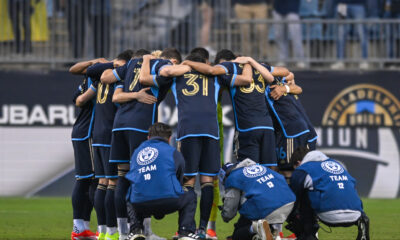Brotherly Game
After slow start to the season, the Philadelphia Union will find their form

So the Union slipped again in the MLS Power Rankings (They’re 10th as of this writing but will fall again). So the Union went four weeks without a player on the Team of the Matchday (Gazdag and Carranza from Week 1 and Glesnes from Week 6). So the Union lost two games in a row for the first time since September 2021. (It was three in a row if you count the Club America loss).
The Union have high expectations. Tenth place in the Eastern Conference is not where the Eastern Conference Champions belong, not after being minutes from an MLS Cup. It’s inevitable the lack of early success is leaving fans dry-heaving from four disappointing losses, a lifeless tie, and a gift for a win (2 if you add Atlas Leg 1). And to be clear, it’s not just the losses, ties, and
wins but the manner in which the games were played. Chaotic, undisciplined, and soft are not adjectives often used to describe the modern day Philadelphia Union. But despite all that, the Union will adjust.
There are reasons to be concerned, and there are an equal number of reasons not be concerned. Over the course of a long season, teams will have dips and peaks, but one game doesn’t define the next in the same way successful seasons don’t guarantee continued success.
For the Union to earn another trip to the MLS Cup final and advance to the next step in the Concacaf Champions League, they’ll need to find their form. With the people involved, from the players and coach to the front office, all signs point to them figuring it out.
Sure, the Union haven’t looked like themselves to start the season, but questions remain as to how much has been them and how much their opponents. The Union way hasn’t changed for years. The tape exists. A good coach doesn’t have to research deep, and with that comes a blueprint for beating the Union. Much of that formula starts with pressure. The Union haven’t established their typical level of pressure. According to FBRef, the Union are tied for 8th in the league in tackles (118), tied for 7th in tackles in the attacking third (15), and tied for 8th in tackles in the middle third (50). In previous seasons, they spent a majority of the season in the top-three in most defensive categories. Not is all lost though as their interceptions rank 3 rd (90) and their tackles plus interceptions ranks 4th (208).
Blame could be placed on the energy of playing so many games early in a season, but credit should go to their opponents’ style of play. Against Orlando, the counter threats from Martín Ojeda and Iván Angulo were so dynamic that Olivier Mbaizo and Kai Wagner were ineffective going forward. The Union were forced to play through the middle and into Orlando’s strength, while on the other end, couldn’t trap their creative players and establish a cohesive press.
Given time, Mauricio Pereyra can pick a team apart. He has the vision of a Lucas Zelaráyan, Carles Gil, or Nicolás Lodeiro, and he showed that class on two quick goals that forced the Union to play from behind, their greatest weakness.
“I think everybody on the field said ok I’ll help out and I’ll do more,” Union coach Jim Curtin said after the Orlando game, “and then you started to see us kind of running out of that zone and trying to cover guys, do the job of two people. And all of a sudden now there’s just gaps and holes everywhere.”
As the Union tried to force the game, the field opened up, playing into Orlando’s hands. “I sit on the sidelines and say to my assistants this isn’t the kind of game we want to play,” Curtin added, “and when it starts to go end to end and it’s disorganized, it’s fun to watch maybe because it’s just scrambles and last-ditch tackles, but we’re not built to win those games.”
Against Kansas City, the Union faced a different opponent, only this time it was the visitors trying to assert their physical edge so the Union couldn’t. “Everyone loves to talk about formation and style of play and all this stuff,” Sporting KC coach Peter Vermes said after the game. “I think, at the end of the day, what you have to bring to every game in MLS is this high level of intensity and effort. If you don’t, you’re going to get knocked off the park no matter who you play.”
Vermes’ side, currently tied for last place in the West at 3 points, on par with Montréal, who beat the Union 3-2 at the Stade Olympique, made the Union press disjointed and unable to find any rhythm going forward. It wasn’t until a late flurry when the Union even looked like scoring.
“I don’t want to get too deep into the tactics,” Vermes said, “but because they play a diamond in the middle, a lot of times whatever side the ball is on, those four guys are very focused on that side of the field. So when they switch it to that guy over there, he doesn’t have a lot of support. So our objective was to try to get there quick and put him under a lot of pressure.”
The Champions League has produced similar performances albeit more favorable results. Against Atlas, the Union used a formation wrinkle, mostly due to the squad rotation, but also because of Atlas’ ability to break on the counter. The Union came out in a Christmas tree formation for the first time this season, using Julian Carranza as the lone striker ahead of Daniel Gazdag and Joaquin Torres. Playing a man up in the second half helped, but early on the change appeared to help control the midfield.
“That’s more of a coach’s decision,” captain Alejandro Bedoya said after the Atlas game, “but we’ve been missing a little bit extra these past couple games and just had to go more like a 4-3-2-1 to clog the middle so that we can have more numbers in there and play out of the back a little bit more. And we had guys like Daniel and Joaquin who can play to their feet and get a little bit more on the ball. So I think it kind of worked in the first half in terms of us playing out of the back a little bit more, keeping possession more. We switched it up in the second half, and we’re trying to open them up and obviously get some more runs in behind.”
The uncharacteristic concession of goals has also affected the Union’s start. Last season, the Union set a league record for goals against in a 34-game season with 26. In the first five games, the Union conceded 8 goals. It took them 10 games last season to concede 8 goals.
Andre Blake missed some games due to injury, and Joe Bendik filled in admirably even though some of the conceded goals would have been given up no matter who was playing. Back-to-back shutouts at home against SKC and Atlas carry some weight in building a formidable defense, and the all-out defensive plan against FC Cincinnati worked for 69 minutes. Even though only four teams have conceded more goals than the Union in league play to start the season (9), the Union have only given up 21 shots, 4th fewest in the league.
There’s some good news after the first games of the MLS season. Check out the following graph from Aldo Comi:
MLS xG created and conceded: update after MD 07:
🔹 #NERevs are really defying xG gravity 🧐
🔹 #EveryoneN kind of boring to watch 😅
🔹 #Sounders should be 1st in power rankings 🚀#MLS pic.twitter.com/1TfxVMqen2— Aldo Comi (@aldocomi) April 9, 2023
According to Comi’s visual, the Union still rank among the top in the league in expected goals created to expected goals conceded. Though they may not be the dominant force defensively or offensively, they’re not far off. Scoring goals has held the Union back the most.
According to FBRef, the Union rank 4th in MLS in shot creation per 90 minutes with 26.14. But here is where things start to go wrong. Their shot on target percentage (SOT%) is 29.7, their goals minus expected goals (G-xG) is -2, and their non-penalty goals minus non-penalty expected goals (npG-npxG) is -2.6, all 22nd in the league. That means they’re creating enough chances to score but not finding the target and/or being stopped by solid defending/goalkeeping. Essentially, the Union are being out-Unioned in the penalty area.
However, none of those numbers concern the Union. “We played six games in the season so far in the league and a couple games in Concacaf,” Daniel Gazdag said after the Atlas game. “We’ve been struggling a little bit to score goals compared to last season because last season everything came so easy, but this season is different. We still have the same players. We proved that we can score a lot of goals. I’m sure it will change and we can get that again.”
Captain Alejandro Bedoya also is not worried about the team’s finishing. “The most important thing is we do have that chance creation,” he said. “It’s not like we’re lacking in creating chances, so that’s the positive. We just need to continue to stay mentally strong.” Bedoya pointed out that the Union went through something similar early last season before finding their rhythm. “We know that we are creating chances. The scoring will come as long as we keep staying confident and pushing each other.”
With Mikael Uhre and Julian Carranza struggling to find goals, another big concern for the Union has been striker depth. Cory Burke has been a bigger loss than expected. Striker depth hurt them at times last year until Burke stepped up and became an influential player off the bench. Quinn Sullivan put in a decent performance against Cincinnati. He held the ball up, created a good chance for Jesus Bueno that could have stolen the first goal, but Chris Donovan didn’t play well against Cincinnati, and it wasn’t the first game that happened. His minutes may be numbered going forward. At this level, with the starters struggling, the Union need an attacking player off the bench to affect a game. Currently, that player is not on their roster.
Daniel Gazdag leads the Union with a 3.15 expected goals plus expected assists (xG+xA) according to American Soccer Analysis, good for 17th in MLS. Mikael Uhre ranks second on the team with 1.67 and 76th in the league. Alejandro Bedoya (1.63) and Jack Elliott (1.51) are next at 78th and 84th respectively. Uhre has .80 goals minus expected goals (G-xG), which ranks 44th, and
Joaquín Torres has .66, which ranks 59th. They are the only two Union players with a positive value.
Meanwhile, as the Union’s offensive struggles continue, they have received a major boost from Damion Lowe, who’s allowed Curtin to rotate his center backs, something he rarely does. Lowe’s experience and intensity proved invaluable in his few starts this season, mostly in CCL, but there’s no doubt we’ll see him feature in MLS games down the road.
“It’s important to remember that whether we’re in form, whether we’re out of form, we still have it in us to play big in an elimination type of atmosphere,” Curtin said after the Atlas game, “so these guys have found a way to navigate competitions to survive and advance and get through things. A lot of them have played in big games, whether it be with the Union, you know, as recently as four days ago, Damion played for Jamaica against Mexico in a hostile environment and held up but did a good job and got confidence from that.”
Against Atlas, Lowe battled winger Julián Quiñones, who had a game-high 5 shots. “When you get a player of the quality of Quinones in space, he’s very dangerous,” Curtin said. “When you get him in 30-40 yards of space and you’re by yourself, there’s not many people that athletically can hold up and keep up, and Damion did a great job of reading things early, winning head balls, poking balls away, winning physical duels and tackles.”
Union captain Bedoya has been impressed with Lowe’s contributions. “We got to come out with the right intensity and match the intensity,” he said after the Atlas game, “and I thought a guy like Damion comes in, steps up, and you saw how good he was with their strikers, putting out fires and winning those physical battles.” Lowe, an experienced player who spent his early years with Seattle and Minnesota in the USL before several seasons overseas, has 50 caps for Jamaica and played 28 games last year for Inter Miami.
“I thought he was fantastic,” Bedoya added. “I told him right up to the gate. He was the first guy I went to and said you put in a great shift. We need guys like that. And especially in center backs that are up for the challenge in one v ones versus a guy like Quinones.”
The Union have not started strong, but it’s April. Supporters Shields are not won in April. Playoff berths are not earned in April. MLS Cups are not decided in April. If anything, the Union are playing comparatively to seasons past. They currently sit at 2-4-1, which isn’t great. Last season, the Union jumped out to a club-best 4-0-1 record after five games then settled to 5-2-3 after the first ten games. In 2021, when they also juggled CCL, they opened the season 1-2-2 then moved to 5-2-3 after the first ten. In the Covid-interrupted season of 2020, the Union opened at 2-1-2, with games three, four, and five coming in the MLS is Back Tournament months after the season paused in March. When the league resumed (not counting the 2 wins and 1 loss in the knockout rounds of MIB), the Union moved to 5-2-3 after the first ten games.
After Atlas, they’ll travel to Chicago (2-1-3), one of the Union’s wins, then host Toronto (1-1-5) before traveling up the road to face the Red Bulls (1-2-4). The following two games are at Colorado (1-3-3) and home to D.C. (1-4-2). With their next five games against opponents also struggling to get results, the Union may need to battle to get points, something they’re comfortable doing.
“The past seasons we’ve been able to grind results,” Bedoya said, “even the games we’ve won like four, five, six-zero, I can recall a D.C. United game last year they could have been up three-zero. We ended up winning the game six-zero, but we just grinded it out, got through those tough moments, and we’re able to pull out a victory. We haven’t been able to really do that this year.”
Curtin believes grinding out results against a quality opponent like Atlas can have a larger impact on the early season. “Confidence in players is key,” he said. “I mentioned it last game (SKC). We weren’t 100% confident in ourselves and these types of wins against good teams can give confidence and kickstart a season just like that Open Cup run can, a Champions League run can, a Leagues Cup run when that competition comes in July.”
Finding form ultimately comes down to the experience of knowing the Union have been here before. And once they begin to find those small successes, it may not take long to find their late-2022 rhythm again. “The margins in this sport are so tiny,” Curtin said, “so for our guys to get a result, to grind out a one-zero, having success is something that I think will give confidence as we move forward in our season for sure.”
Will anyone remember these results in September and October? If the Union are still fighting for the playoffs, sure, but in all likelihood they’ll find their place among the Eastern Conference elite again and these early games won’t matter as much. The Union are too experienced, too good, and have too many strong leaders in the locker room to fail. If anything, being knocked down a few pegs has meant the rest of the league no longer considers them the world-beaters of last year, which suits the Union just fine.


















